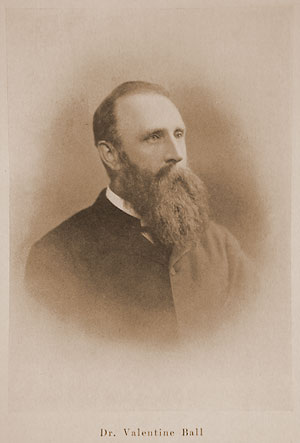Valentine Ball facts for kids
Quick facts for kids
Valentine Ball
|
|
|---|---|
 |
|
| Born | 14 July 1843 |
| Died | 15 June 1895 (aged 51) |
| Nationality | Irish |
Valentine Ball was an important Irish scientist who lived from 1843 to 1895. He was a geologist, which means he studied rocks and the Earth's history. Valentine was part of a famous family of scientists. His father, Robert Ball, was a naturalist, and his brother, Robert Stawell Ball, was also a well-known scientist. Valentine spent twenty years working in India before coming back to Ireland for his work.
Contents
Early Life and Family Background
Valentine Ball was born in Dublin, Ireland, on July 14, 1843. He was the second son of Robert Ball and Amelia Gresley Hellicar. His family included several talented people. His brother, Robert Stawell Ball, became a famous astronomer. Another brother, Charles Ball, was a respected surgeon.
Valentine went to school in Chester and Dublin. He later studied at the University of Dublin. He earned his first degree in 1864.
Valentine's Family Life
In 1879, Valentine Ball married Mary Stewart Moore. They had two daughters, Maude Mary Ball and Ethel Gresley Ball. Both of their daughters grew up to be artists. Their only son, Robert Gordon, worked as a doctor in West Africa.
Valentine Ball passed away on June 15, 1895, in Dublin. He was buried in Mount Jerome cemetery.
Valentine Ball's Career as a Geologist
Valentine Ball started his career in 1864. He joined the Geological Survey of India. This organization studies the Earth's surface and rocks in India. He worked under a scientist named Thomas Oldham. Ball's main job was to find coalfields and other valuable minerals. He discovered several new coalfields in different parts of India.
In 1875, he became a Fellow of the Calcutta University. Because of his knowledge of central India, people asked for his advice. They wanted help planning a railway line between Bombay and Calcutta. He was also one of the first scientists to visit Narcondam Island in 1873. In 1874, he became a Fellow of the Geological Society of London.
Return to Ireland and Museum Work
Valentine Ball returned to Ireland in 1881. He became a professor at the University of Dublin. He taught geology and mineralogy there. In 1883, he became the director of the Dublin Science and Art Museum. This museum is now known as the National Museum of Ireland.
As director, Ball helped finish the new museum building on Kildare Street. He also wrote the first guide to the building. He was also interested in ornithology (the study of birds) and anthropology (the study of human cultures). He made sure that important collections were moved to the new museum. These included Irish historical items and artifacts from Polynesia. Valentine Ball resigned from his museum role in 1895 due to poor health.
Publications and Legacy
Valentine Ball wrote many scientific papers and books. He often contributed to Stray Feathers. This was a journal about birds started by Allan Octavian Hume. Hume even named a type of owl after him, the Andaman scops owl (Otus balli).
Some of his well-known books include:
- Jungle-Life in India (1880)
- The Diamonds, Coal, and Gold of India (1881)
- The Economic Geology of India (1881)
After he passed away, his wife published his translation of Tavernier's Travels in India (1889).
Today, the National Museum of Ireland keeps many of his collections. They also have a marble statue of Valentine Ball. The National Botanic Gardens hold his collection of Indian lichens. His letters are kept at Kew Gardens.

